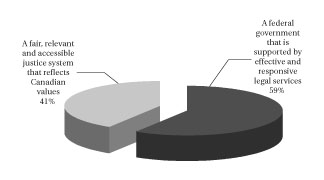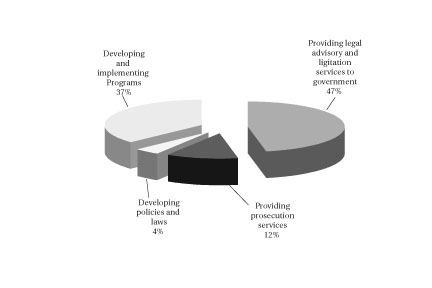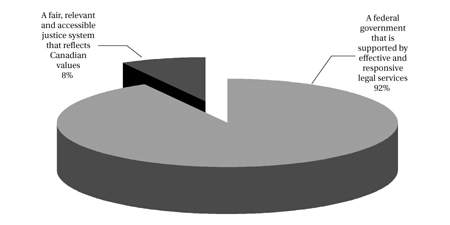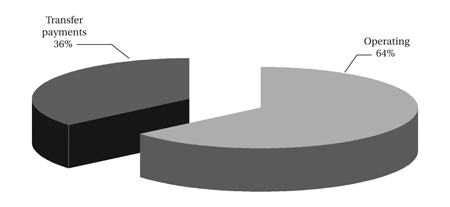Common menu bar links
Breadcrumb Trail
ARCHIVED - Department of Justice Canada
 This page has been archived.
This page has been archived.
Archived Content
Information identified as archived on the Web is for reference, research or recordkeeping purposes. It has not been altered or updated after the date of archiving. Web pages that are archived on the Web are not subject to the Government of Canada Web Standards. As per the Communications Policy of the Government of Canada, you can request alternate formats on the "Contact Us" page.
Section I – Overview
Minister's Message

I am pleased to report on the perform ance of the Department of Justice for 2006-2007.
The Department of Justice plays an important and unique role in the federal government and in Canada’s justice system. Over the past year, the Department has assisted the Government as a whole in implementing a legislative agenda that aims to make streets and communities safer, while ensuring that the justice system remains fair, relevant and accessible.
The Department provided support for the introduction of a number of pieces of legislation of importance to Canadians. These included bills to toughen sentences for serious gun offences, to require those accused of serious crimes involving firearms to provide sufficient justification before they are granted bail while awaiting trial, and to increase the age at which youths can consent to sexual activity, in order to better protect them against sexual exploitation by adult predators.
Thanks in part to the efforts of the Department, the Government has passed legislation to deal with the dangerous and reckless crime of street racing, to end the use of conditional sentences – including house arrest – for serious offences, to provide provinces and territories with the flexibility to regulate the payday lending industry, and to ratify and implement the United Nations Convention Against Corruption, a key international initiative. The Department is also helping the Government in its initiatives to prevent youth crime in communities, and to assist victims of crime.
The Department was also a key contributor to the drafting of the Federal Accountability Act, which received Royal Assent on December 12th, 2006. Moreover, as a common service provider to all federal government departments and agencies, the Department provided high-quality legal services support to clients to help them meet their obligations to Parliament and Canadians.
Work also continues on issues such as a sustainable funding strategy for legal services, managing the volume of litigation, legal risk management, performance measurement, and developing the skills and knowledge of our work force.
As Minister of Justice, I will be counting on the Department’s public servants, and their professionalism and expertise, as our Government continues to pursue this agenda. I will also continue to work with all levels of government, our stakeholders and the public in our ultimate goal of ensuring that Canadians feel safe in their communities and have confidence in the justice system.
I invite you to read this document for further details regarding our performance over the past year.
The Honourable Rob Nicholson, P.C.,M.P.
Minister of Justice and Attorney General of Canada
MESSAGE FROM THE DEPUTY MINISTER
The Department of Justice strives for excellence in the practice of law. It is a leader in Canada and internationally and at the forefront of legal issues that are relevant to the daily lives of Canadians. The Department helps the federal government to develop policy and to draft and reform laws as needed so that priorities and key commitments are realized to the benefit of all Canadians. Over the past year, in support of the Minister and the Government, the Department was focussed heavily on the delivery of the legislative agenda.
One of the major pieces of legislation that received Royal Assent during the reporting period was the Federal Accountability Act. A key element of the Act was the creation of the Public Prosecution Service of Canada (PPSC). As a result, the Department was engaged in managing the transition of approximately 15 percent of former DOJ employees from the Federal Prosecution Service to the PPSC.
In the 2006-2007 Report on Plans and Priorities, I committed to building our performance management capacity. As such, over the past year, we have seen much progress in our capacity to collect and report on a number of performance indicators particularly those associated with the full range of legal services that we provide to the Government of Canada. For example, during the fiscal year 2006-2007, in partnership with Statistics Canada, the Canada Public Service Agency, and PublicWorks and Government Services Canada, the Department surveyed over 24 agencies and departments to obtain feedback regarding the utility, timeliness and responsiveness of our services. For more details regarding the results of this exercise, and other performance data and analysis, the reader is invited to review Section II of this report.
During the reporting period, for the first time, the government publicly posted the results of the Government-wide 2005-2006 Management Accountability Framework (MAF) exercise. This important initiative illustrates that the government is serious about transparency, accountability and most importantly, sound stewardship of resources. I am pleased overall with the ratings accorded to the
Department and I welcome the codification of sound management practice with clear standards defined across government. Within this framework, we are able to clearly pinpoint priorities, highlight best practices and address any shortcomings. It is also interesting to note that those issues identified by the MAF exercise as ones requiring attention from the Department were elements that we had also
identified internally as areas of
focus. For example, over the reporting period, we continued our work in the area of legal risk management, that is, to ensure that legal risk across the federal government is anticipated, mitigated and effectively managed. We also completed our work on the Review of Legal Services and obtained approval for the implementation of a net voting regime for the appropriate spending of revenues received
from departments and agencies for the legal services rendered. Treasury Board Secretariat approved the reliance on a mix of Justice appropriations and recoveries from departments and agencies to fund the provision of legal services to Government.
Finally, as you will see in the following pages, we continued to dedicate our efforts throughout the reporting period to support our strategic outcomes and to providing concrete results for Canadians.
Management Representation Statement
I submit for tabling in Parliament, the 2006–2007 Departmental Performance Report for the Department of Justice Canada.
This document has been prepared based on the reporting principles contained in the Guide for the Preparation of Part III of the 2006–2007 Estimates: Reports on Plans and Priorities and Departmental Performance Reports- It adheres to the specific reporting requirements outlined in the Treasury Board
Secretariat guidance; - It is based on the department's approved Strategic Outcomes and Program Activity
Architecture that were approved by the Treasury Board; - It presents consistent, comprehensive, balanced and reliable information;
- It provides a basis of accountability for the results achieved with the resources
and authorities entrusted to it; andIt reports finances based on approved numbers from the Estimates and the
Public Accounts of Canada.
John H. Sims
Deputy Minister of Justice and Deputy Attorney General of Canada
Summary Information
Raison d'ętre
The justice system defines and prescribes the balance between collective and individual rights and responsibilities that ensure a well-ordered society. As such it affects almost every facet of Canadians' daily lives from guiding everyday activities that ensure our safety to supporting social policies and social benefits, regulating our economy, and offering ways to resolve disputes peacefully where there are disagreements or conflicts between people, organizations, and/or governments.
Maintaining a system that serves all Canadians is a central focus for the Department of Justice (DOJ), which strives to ensure that the system remains fair, accessible and efficient as it evolves in response to social change.
Role of the Department
- The Department of Justice is headed by theMinister of Justice and the Attorney General of Canada. The responsibilities of the Minister and Attorney General are set out in the Department of Justice Act (DOJ Act) and 47 other Acts of Parliament. The Department of Justice fulfills three distinctive roles within the Government of Canada, acting as a:
- policy department with broad responsibilities for overseeing all matters relating to the administration of justice that fall within the federal domain;
- provider of a range of legal advisory, litigation and legislative services to government departments and agencies; and
- central agency responsible for supporting theMinister in advising Cabinet on all legal matters including the constitutionality of government activities.
Mission
The Department’s mission is to:- Support the Minister of Justice in working to ensure that Canada is a just and law-abiding society with an accessible, efficient and fair system of justice;
- Provide high-quality legal services and counsel to the government and to client departments and agencies; and
- Promote respect for rights and freedoms, the law and the Constitution.
Program Activity Architecture
The Program Activity Architecture (PAA) graphically portrays an inventory of the activities and programs for which the Department of Justice is responsible. In essence, most everything that we do in the department is reflected in our PAA, whether it be policy development, program development and delivery (including grants and contributions), or the provision of legal advisory, legislative and regulatory drafting and litigation services to our colleagues across government.
Within the PAA structure, the Department has two overarching strategic outcomes which we strive to attain: a fair, relevant and accessible justice system that reflects Canadian values; and a federal government that is supported by effective and responsive legal services.
The Department’s two strategic outcomes stem from its statutory requirements under the Department of Justice Act. The Program Activities that support these strategic outcomes are aimed at achieving high level results including the development of policies, laws and programs in response to identified needs and gaps and that are integrated with Government priorities and commitments; the provision of high quality legal services; and, respect for the rule of law.
Figure 1 below illustrates the alignment of the Department’s program activities and strategic outcomes with those of the Government of Canada.
Figure 1: Benefits to Canadians – Links to Government of Canada Outcomes
|
Strategic Outcome
|
Program Activity
|
Alignment to Government of Canada Outcomes
|
| A fair, relevant, accessible justice system that reflects Canadian values |
Program Activity A.1 Developing policies and laws | Social: Safe and Secure Communities |
| Program Activity A.2 Developing and implementing programs and Social Inclusion | Social: Diverse Society That Promotes Lingustic Duality | |
| A federal government that is supported by effective and responsive legal services | Program Activity B.1 Providing legal advisory, litigation and legislative services to government |
Federal Organizations that support all Government of Canada outcomes |
| Program Activity B.2 Providing prosecution services1 | Social: Safe and Secure Communities |
Financial Resources (in millions of dollars):
|
Planned Spending
|
Total Authorities
|
Actual Spending |
|
$ 1,005.7
|
$ 1,028.6
|
$ 974.2
|
Human Resources (in Full-time Equivalents or FTEs):
|
Planned
|
Actual
|
Difference
|
|
4,783 FTEs
|
4,812 FTEs
|
29 FTEs
|
2006-2006 Actual Spending by Strategic Outcome and Supporting Program Activity (in millions of dollars) |
| A fair, relevant and accessible justice system that reflects Canadian values | |
|
Developing policies and laws |
37.5
|
|
Developing and implementing programs |
363.0
|
|
Total - Strategic Outcome I
|
400.5
|
| A federal government that is supported by effective and responsive legal services | |
|
Providing legal advisory, litigation and legislative services to government |
416.0
|
|
Providing prosecution services |
112.7
|
|
Total - Strategic Outcome II
|
573.7
|
| Total |
974.2
|
2006-2007 Actual Spending by Strategic Outcomes

2006-2007 Actual Spending by Program Activity

2006-2007 Actual FTEs by Strategic Outcome and Supporting Program Activity |
| A fair, relevant and accessible justice system that reflects Canadian values | |
|
Developing policies and laws |
260
|
|
Developing and implementing programs |
107
|
|
Total - Strategic Outcome I
|
367
|
| A federal government that is supported by effective and responsive legal services | |
|
Providing legal advisory and litigation services to government |
3625
|
|
Providing prosecution services |
820
|
|
Total - Strategic Outcome II
|
4445
|
| Total |
4812
|
2006-2007 Actual FTEs by Strategic Outcome

|
PRIORITIES
All priorities are "on-going" |
PROGRAMACTIVITY AND EXPECTED RESULTS
|
2006-2007
($MILLIONS) |
|||||
|
Strategic Outcome #1:
A fair, relevant and accessible justice systemthat reflects Canadian values |
Strategic Outcome #2:
A federal government that is supported by effective and responsive legal services |
||||||
|
Status on performance:
All priorities were "successfullymet" in 2006-2007 |
ProgramActivity: Expected Results: Policies and laws are developed in response to identified needs and gaps and are integrated with government priorities and commitments |
Program Activity: A.2 Developing and implementing programs Expected Results: Programs are developed and implemented in response to identified needs and gaps and are integrated with Government priorities and commitments |
ProgramActivity: B.1 Providing legal advisory and litigation Expected Results: High quality legal services and respect for the rule of law |
ProgramActivity: B.2 Providing prosecution services Expected Results: Effective pre-charge interventions/advice |
Planned Spending | Actual Spending | |
| A. Protecting Canadian communities |
|
|
|
42.3
|
44.4
|
||
| B. Improving Government Accountability |
|
|
0.5
|
0.5
|
|||
| C. Strengthening youth criminal justice |
|
|
192.9
|
187.3
|
|||
| D. Improving the experience of victims of crime |
|
|
4.8
|
4.1
|
|||
| E. Improving efficiencies in the justice system and the efficient deliveryof legal services |
|
|
|
562.8
|
506.2
|
||
| F. Improving access to justice |
|
|
164.4
|
151.7
|
|||
Operating Environment:
The Department of Justice is a medium-sized department. During the reporting period, the Department had 4,812 employees While roughly one half of departmental staff are lawyers, there are a number of other committed professionals in the Department including paralegals, social scientists, human resource officers, program managers, communications specialists, administrative services personnel, computer services professionals and financial officers.
As the government's law firm, the Department is structured in a way that anticipates maximum effectiveness in serving our clients' needs. To this end, the Department delivers an integrated suite of legal advisory, litigation and drafting services through six "portfolios" - Aboriginal Affairs; Tax Law; Citizenship, Immigration and Public Safety; Central Agencies; Business and Regulatory Law; and the Justice Portfolio.
This portfolio approach to service provision is aimed at ensuring consistency of positions on important points of law, and in the policies, programs, legislative and regulatory initiatives developed across the federal government.
Within the portfolio structure, a significant proportion of the Department's counsel are assigned to one of the 42 departmental legal services units (DLSUs), which are co-located with client departments and agencies. DLSUs provide legal advice to their clients with respect to their powers and duties, and ensure that the conduct of their affairs are in accordance with the law. In doing so, DLSUs also provide advice with respect to the statutes and regulations that apply to the Government of Canada, and strategic advice concerning policy development and other initiatives.
The Department also maintains a number of specialized legal capacities within national headquarters including a Legislative Services Branch, a Litigation Branch and a Public Law Branch. In addition to a national headquarters and a network of legal services units, the Department provides services across the country through a network of regional offices and sub-offices. Six regional offices—serving the North, British Columbia, the Prairies, Ontario, Quebec, and the Atlantic provinces—support the portfolio structure by serving clients and handling litigation and legal advisory work locally. During the reporting period, about half the Department's staff worked in regional offices. Following the establishment of the Public Prosecution Service of Canada, this number was reduced to 43 percent.
Regional staff are responsible for effectively managing a large volume of litigation and advisory services on behalf of client departments. They work closely with their portfolio and policy colleagues to handle complex, high-profile cases.
The Department also maintains a policy and program development capacity in order to manage its contributions to the government of Canada's policy and programpriorities and commitments with regard to the administration of justice. In addition to managing the Department's overall policy agenda, the Department's Policy Sector develops and maintains strong working relationships with policy and program partners in the federal government, provinces and territories, non-governmental organizations and international institutions and organizations
2. This includes employees who were transferred to the Public Prosecution Service of Canada..
The Department has two types of expenditures: operating expenditures ($619.2M or 64 percent of total expenditures) and transfer payments ($353.1M or 36 percent of total expenditures). The operating expenditures are predominantly devoted to staff and related costs (salary, training, office equipment, etc.). About 59 percent of the Department’s total spending was devoted to the delivery of prosecution services and of integrated advisory, litigation and legislative legal services to client departments and agencies. A significant portion (35 percent) of the operating expenditures incurred in delivering legal services is recovered from client departments and agencies.
2006-2007 Actual Spending by Type of Expenditures

As well, 41 percent of the departmental budget is directed to transfer payment programs and their associated funding mechanisms including contributions to the provinces and territories to assist in the delivery of youth justice services, legal aid and access to justice services in support of federal policy objectives. This includes the administration of the transfer payment programs as well as the activities associated with the development of related laws and policies.
Factors influencing our operating environment
There are many factors that influence our operating environment and thus affect our priority setting and planning. This section provides several key examples of outside influences that impact on our policy and program development, as well as the effective management of the delivery of high quality legal services.
Public Confidence in the Justice System
Canadians rely on the justice system to provide an independent and impartial forum for resolving disputes. The Department is keenly interested in the degree to which the public has confidence in the justice system writ large. In a recent study carried out by the Department , we found that the majority of respondents to a national survey perceive that the family justice system is meeting the needs of Canadian families. As well, more than half of the respondents indicated that they perceive family court judges and family court staff as helping people to sort out and resolve their family justice issues, and 59 percent of respondents indicated that they were “likely” or “very likely” to recommend that a friend or family member go to the family justice system for assistance. For the criminal justice system, the Department of Justice study found that the majority of respondents believe that Judges, Crown Attorneys and police treat all people fairly. When asked how confident they were in the different functions of the criminal justice system, respondents indicated lower levels of confidence in the experiences of victims, in preventing youth crime and in reducing levels of crime. 5
Transparency and Accountability
On December 12th, 2006, the Federal Accountability Act (Fed AA) received Royal Assent. Through the FedAA and accompanying Action Plan, the Government of Canada brought forward specific measures to help strengthen accountability and increase transparency and oversight in government operations.
n line with the Government’s Accountability initiative, Canada introduced Criminal Code amendments to enable Canadian ratification of the United Nations Convention Against Corruption. This important convention includes in the preamble that parties to the Convention are,“concerned about the seriousness of problems and threats posed by corruption to the stability and security of societies, undermining the institutions and values of democracy, ethical values and justice and jeopardizing sustainable development and rule of law.”
An international organization, Transparency International7, has developed a Corruptions Perceptions Index to track and report on citizens’ perceptions and experiences with regard to corruption in their countries. In 2006, Canada was ranked 14th out of 163 countries around the world with an overall score of 8.5 on a scale ranging between 10 (highly clean) and 0 (highly corrupt). In 2007, Canada's ranking improved to 9th out of 180 countries.
16 DEPARTMENTAL PERFORMANCE REPORT 2006-2007
Participatory justice: working with key participants
We work with others in the justice system, including nongovernmental and community-based organizations to generate innovative, cost-effective ways of delivering services that improve access to the justice system and keep it relevant and responsive in a diverse society. Similarly, we work with federal departments and agencies in areas such as safety and security and Aboriginal justice to help
achieve overarching Government of Canada strategic outcomes. At the same time, we are managing a fine balance between priorities and diverse responsibilities. Some of our key participants include:
- Canadian public, including non-governmental and community-based organizations;
- Parliamentarians;
- The judiciary, the Bar and the research community;
- Approximately 50 federal departments and agencies (while the Department refers to federal departments and agencies as "clients" for ease of understanding, it is important to note that all work is done on behalf of the Crown, not a specific branch of the Government of Canada);
- Provinces and Territories with which the Department has shared jurisdiction over the legal system and to which funds are transferred for youth justice, legal aid and other programs; and
- Foreign governments and international organizations, directly and in conjunction with Foreign Affairs Canada.
1 The Program Activity "Providing Prosecution Services" is no longer included in the Department of Justice's Program Activity Architecture. As of December 12th, 2006, with the creation of the Public Prosecution Service of Canada, the majority of the Department's prosecution activities were assumed by the new organization. Because this
machinery change occurred during the reporting period, and because the PPSC's costs were managed by the Department of Justice until March 31st, 2007, their performance report is included in this document. In future years, the PPSC will submit its own DPR to Parliament as it did with the 2007-2008 Report on Plans and Priorities
Public Confidence in the Justice System (McDonald et. al., forthcoming)
In another recent study (Beaupré, Pascale and Elisabeth Cloutier. Navigating Family Transitions: Evidence from the
General Social Survey, 2006. General Social Survey, Cycle 20: Family Transitions Survey, Statistics Canada), Statistics
Canada found that 14 percent of all persons recently separated or divorced made use of Alternative Dispute Resolution
which involves professional services such as mediation and conciliation which are available as an alternative to the
court system. These services are intended to help separating and divorcing persons to resolve conflict and make
decisions in a collaborative manner.
5 Public Confidence in the Justice System (McDonald et. al., forthcoming)
UN Convention against Corruption - Preamble
Transparency International, a composite index that draws on multiple expert opinion surveys that poll perceptions
of public sector corruption, www.transparency.org
Creation of the Office of the Director of Public Prosecutions
One of the key commitments under the Action Plan that accompanied the Federal Accountability Act was the establishment of the Office of the Director of Public Prosecutions. In order to address the requirements of the Director of Public Prosecutions Act, with few exceptions, all employees of Federal Prosecution Service (FPS) within the Department of Justice became employees of the Public Prosecution Service of Canada (PPSC) on December 12th, 2006. This resulted in a transfer of approximately 15 percent of Justice employees to the new organization.
Jurisprudence – the Duty to Consult
As the Government’s “law firm”, it is incumbent upon Justice counsel to assess the implications of a wide variety of outcomes in the court system – both civil and criminal – and incorporate these analyses in the delivery of legal advisory, litigation and legislative services with a view to effectively managing legal risk. The Supreme Court of Canada decision in Mikisew Cree First Nation v. Canada confirmed the Crown’s “duty to consult” with First Nations and stated that this “duty arises when the Crown has knowledge, real or constructive, of the potential existence of the Aboriginal right or title and contemplates conduct that might adversely affect it.”8 The implications of this ruling are far-reaching for a number of government departments and agencies. Consequently, the Department has been working closely with client departments, particularly in the Business and Regulatory and Aboriginal Portfolios, to ensure that the government meets its obligations to consult with First Nations. Working with partners The justice system is multi-tiered and includes partners such as nongovernmental and community-based organizations who assist us in generating innovative, cost-effective ways of delivering services that improve access to the justice system, including access to justice in both official languages and to ensure it is relevant and responsive to a diverse society. Similarly, we work with federal departments and agencies in areas such as safety and security and Aboriginal justice to help achieve overarching Government of Canada strategic outcomes. Some of our other key partners include:- the Canadian public, including non-governmental and community-based organizations;
- Parliamentarians;
- the Judiciary, the Bar, La Chambre des notaires du Québec;
- law faculties and the research community;
- approximately 50 federal client departments and agencies9;
- Provinces and Territories; and
- foreign governments and international organizations, directly and in conjunction with Foreign Affairs and International Trade Canada.
8 Mikisew Cree First Nation v. Canada (Minister of Canadian Heritage), [2005] 3 S.C.R. 388, 2005 SCC 69, para 33.
9 While the Department refers to federal departments and agencies as “clients” for ease of understanding, it is
portant to note that all work is done on behalf of the Crown, not a specific branch of the Government of Canada
